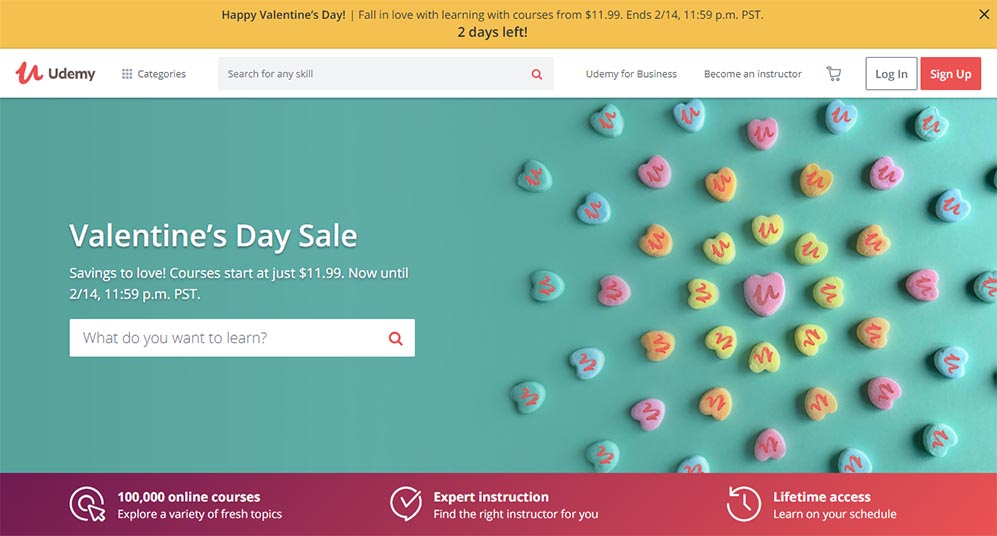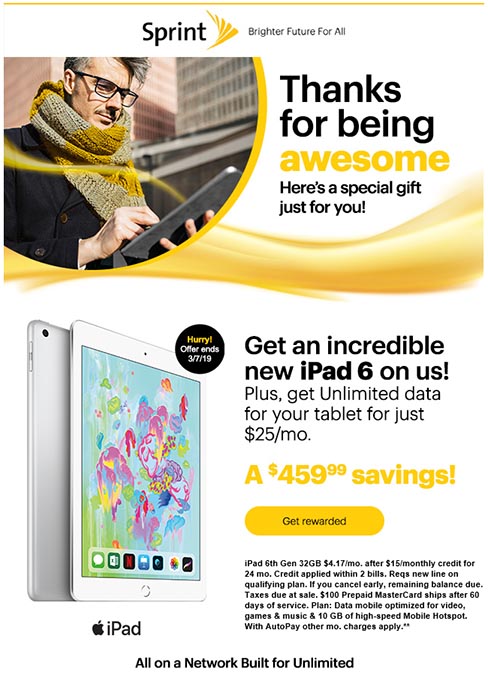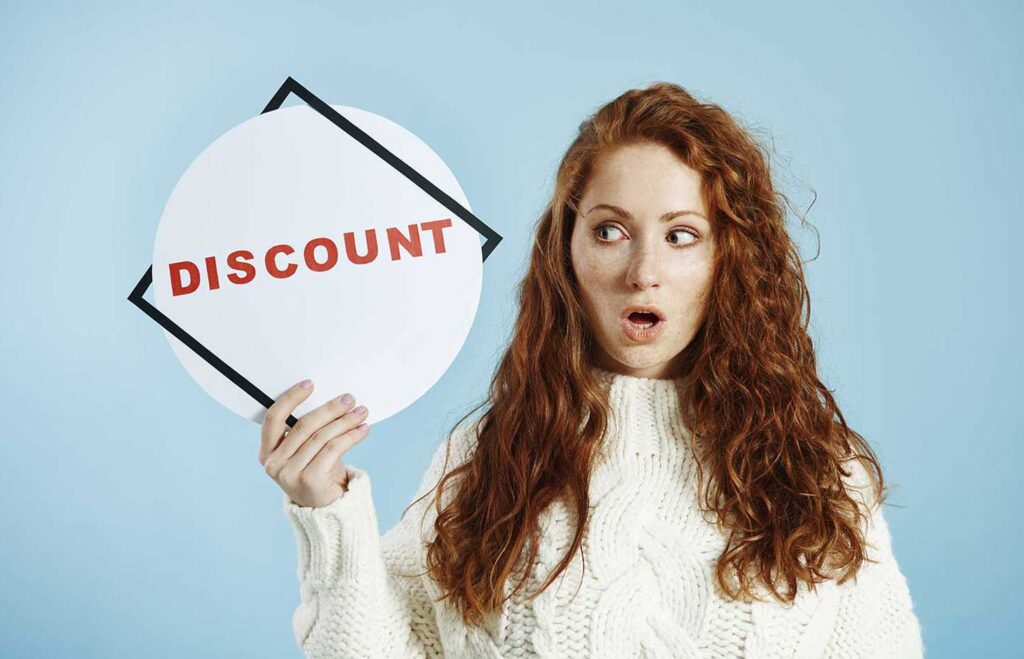If this were a scene from a movie starring your business venture, you’d want to watch it over and over again.
Customers see your eye-catching Facebook ad for an exciting new subscription service. They’re enticed. Clicking through to your Facebook page, they’re further excited to find out they can instantly get a $100 discount when they subscribe as a new customer, but only for a limited time.
The next thing you know, 500 new customers have signed up. You now have guaranteed recurring sales on subscription fees, and potential additional sales revenue from existing and future offerings.
You feel great knowing somewhere out there, 500 satisfied customers will be using your product over the next few months, while your sales revenues climb.
Who can resist a bargain?
Black Friday customers have historically taken advantage of early bird promotions at giant retail stores like Walmart and Best Buy, so you know getting discounts is a major consumer motivator. Customers will even camp out overnight, making sure they’re able to take advantage of the stores’ exclusive deals—particularly on expensive electronic items.
According to Adobe Analytics, online retailers raked in a total of $34.4 billion in sales between American Thanksgiving and Cyber Monday in 2020. This was a nearly 21% surge over the same period in 2019. The pandemic undoubtedly played a role in these figures as consumers were pushed online to do their shopping.
Customers love promotional and discounted pricing
Discounts are big factors in determining why customers go out of their way to buy products or subscribe to offers on an on-going basis from businesses. Discounts draw new customers to businesses and encourage them to try out products, driving sales and profitability in the process.
Businesses have increasingly taken advantage of the potential to grow revenues by running discount promotions. And according to Statista, 60% of U.S. consumers say discounts are more important to them while shopping online since the start of the Coronavirus pandemic.
Are discounts a good strategy for subscription businesses?
Not all discount strategies are equal. How each will impact a software as a service (SaaS) or subscription-based business in terms of sales growth and customer acquisition will vary.
There are various ways to price discounts. In a recent post, we examined how volume or tiered pricing can significantly impact the output of your pricing model.
A good pricing model paired with effective discounts can maximize growth. Here are seven pricing strategies to consider when utilizing discounts as a tool to increase profits and grow your customer base.
1. Offer attractive discounts to new customers
Acquiring new customers is difficult unless you have a compelling strategy that commands attention. One way to attract customer interest is to offer incentives in the form of discounts or promotions.
For new customers signing up, try offering a discount percentage or a free trial period. This allows customers to sample your product at low or no risk. If possible, pair new customer discounts with a money-back satisfaction guarantee.
The money-back guarantee and free trial work best to give customers a great first impression. You have to be sure customers want more at the end of this initial sampling. Otherwise, the tactic can negatively impact sales targets when customers opt out of subscribing after enjoying a discounted or free product.
Once customers have completed the trial period and made their commitment, maximize your success by enticing them further. There are several ways to do this, such as providing:
- additional products with superior features to choose from
- an exceptional user experience within your website or app interface
- a reliable payment process, and
- excellent customer service.
If you employ these strategies to complement a quality product, you’ll be sure to keep users coming back for more.
Spotify—hailed as one of the most successful subscription-based businesses in the industry—uses this strategy by allowing first-time customers to subscribe for a month free on Spotify premium. Once users have enjoyed personalized, commercial-free playlists on the platform, the desire to stick around is practically a given.
2. Put expiration dates or limits on discounts
Discounts encourage consumers to sign up and commit to subscriptions; deadlines push them to do it quickly. Putting expiration dates or limitations on promotions creates a sense of urgency consumers can rarely resist.
Think of subscription businesses that tell customers the 50% discount on their enrollment fee will expire by midnight and their once-in-a-lifetime discount may not be offered again. Ever.
It’s difficult to ignore compelling CTAs, or calls to action, such as the following.
- This Exclusive Offer Expires by Midnight
- Redeem NOW
- Get it NOW before it’s GONE
- CLAIM it while it’s HOT
They’ll also say the offer is good only for the FIRST 1,000 subscribers or that the products are LIMITED IN QUANTITY, ALMOST OUT OF STOCK, or WILL BE DISCONTINUED.
While some of these specific examples may be a bit over the top, scarcity is a persuasive strategy that works to create a sense of urgency among consumers—especially in e-commerce sales.
3. Give competitive discounts or partner with popular brands
Most abandoned shopping carts and coupons occur when customers surf the web or receive word-of-mouth recommendations for better subscription offers.
Before creating an offer, make sure discounts are competitive. If not, you run the risk of being ignored by potential customers who’ve done their research.
If you can’t offer a competitive discount, try running a discount promotion with irresistible, limited-time incentives like seasonal or exclusive products your customers are itching to own.
For example, a SaaS company could package some of its high-performing online tools with discount promos to further entice potential customers.
Collaborate with a popular brand when bundling promotions. Giant telecom brands now use this strategy for their customers. T-Mobile offers free Netflix to its eligible subscribers while Sprint and AT&T add value to their new promos with Hulu and HBO, respectively.
4. Get rid of inventory by offering overstocked, outdated, or discontinued products as freebies
If your inventory includes products that are about to expire or will be discontinued in production, include them in upcoming marketing efforts. Offering aging inventory as free gifts to new subscribers kills two birds with one stone.
One, you ease your inventory levels with products that are already being phased out. Two, a strong relationship is built by providing new customers with useful free gifts. Tempt new subscribers by offering a free set of gifts upon signup, and your overstock helps leverage sales.
5. Offer products that consumers can’t afford during the regular retail season
Some consumers wait for sales events on products that have relatively high price tags.
For example, Amazon’s Prime Day in July is a hyped-up day of deep discounts for certain products. Not only does Amazon offer substantial savings on many of its popular products such as its Kindles and Echoes, but other retailers that sell through Amazon can capitalize on this day. In 2020, Amazon’s Prime Day grossed about $7B, with third-party sellers moving $3.5B in their own inventory.
If your business offers training courses to members and the average price tag per course is high, identify and offer your popular courses to new subscribers for a limited time discount. Udemy ran this type of promotion for Valentine’s Day in 2019.

Tell potential subscribers, of course, that discounted offers are only available to new members for a limited time. Once they’ve opted in, stress additional benefits, including guaranteed discounts in future offerings. Solidify the relationship by reiterating that non-members pay the full price for the same products.
6. Reward loyal members
This strategy is a relationship-building marketing tactic that can strongly influence potential subscribers to sign up.
By offering reward or loyalty programs in the form of discounts, new subscribers may join knowing they’ll enjoy more benefits when they commit for a longer period.
Let’s say you offer a free set of gifts or a discount to new customers upon sign up. Entice them to further take advantage of an offer by promising them another set of gifts or discounts on their first month anniversary as a subscriber. Offer better discounts and more free gifts once they’ve extended their subscription for a longer period.
In the past, Sprint has sent out emails to long-term customers not only offering a free iPad 6, but offering savings on a data plan for the iPad, as well. This doubling-down can maximize both sales and keeping acquired customers at the same time.

Note the scarcity tactic Sprint used here: The offer ended 3/7/19!
Offering loyalty benefits will confirm with newly-acquired subscribers that they’ve made the right choice. They’ll often respond positively by upgrading their subscription for a longer commitment, which translates to more revenue.
7. Convert abandoned cart losses into new sales opportunities
Frequently updated findings by Baymard Institute reveal a nearly 70% average abandonment rate in e-commerce shopping.
Research and identify the products your customers abandon before reaching checkout and offer discounts on those items for a very limited time.
Give customers a gentle follow-up through emails, reminding them they have products in their carts and can get a discount if they want to buy them.
However, it may not be wise to make this a recurring practice for existing customers. Constant discounts can create expectations resulting in a dangerous revenue deficit.
Using discounts to drive customer acquisition, sales, and profitability is a strategy that works, especially for SaaS and subscription-based businesses that require a continued commitment from customers who need an extra push to sign up.
RELATED: 3 Signs That Show It’s Time to Change Your Pricing Strategy
The success of your discounting efforts can be a difficult variable to track manually, but an automated subscription billing platform can help simplify the process for your business. A robust subscription management and billing platform provides the capability to easily deploy discounting and couponing along with real-time insights into activation cohorts and monthly recurring revenue impacts.
If done right—with appropriate strategy and technology enablers—discounting can prove to be a very profitable strategy to boost sales and membership growth.
Quick FAQs about Discount Pricing Strategies
Q: What are some effective discount pricing strategies to drive customer acquisition, sales, and profitability?
There are several discount pricing strategies to drive customer acquisition, sales, and profitability, including:
- Offering new customer discounts or free trials
- Implementing scarcity tactics with limited-time offers or limited-quantity promotions
- Creating competitive discount offers and bundling promotions with popular brands or products
- Offering aging inventory as free gifts for new subscribers
- Providing limited-time discounts on high-priced products
- Implementing reward or loyalty programs with discounts for long-term subscribers
- Offering discounts on abandoned cart items for a limited period
Q: Why are discounts important for businesses, particularly in the SaaS and subscription-based industries?
Discounts are important factors in determining why customers choose to buy products or subscribe to offers from businesses. They attract new customers, encourage them to try out products, drive sales, and increase profitability. For SaaS and subscription-based businesses, which require continued commitment from customers, discounts offer an extra push to sign up and remain engaged with the service or product.
Q: How can scarcity tactics in discount pricing help a business?
Scarcity tactics create a sense of urgency for consumers by attaching expiration dates, limited availability, or unique offers to promotions. Such tactics can persuade consumers to make a purchase decision faster, especially in e-commerce sales, and help a business capitalize on customers’ fear of missing out.
Q: What is the role of loyalty programs and discounts in acquisition and retention of customers?
Loyalty programs and discounts encourage new subscribers to join and commit to businesses for longer periods by offering rewards and benefits as they continue their engagement. By offering incentives to extend their subscription or upgrade their memberships, businesses can not only acquire new customers but also maintain lasting relationships that translate into increased revenue.
Q: What are some considerations when offering discounts on abandoned cart items?
When offering discounts on abandoned cart items, it is important to follow up with customers gently through emails, reminding them of the products in their carts and the limited-time discounts available. However, businesses should avoid making this a recurring practice for existing customers, as constant discounts might create expectations and result in a revenue deficit.








